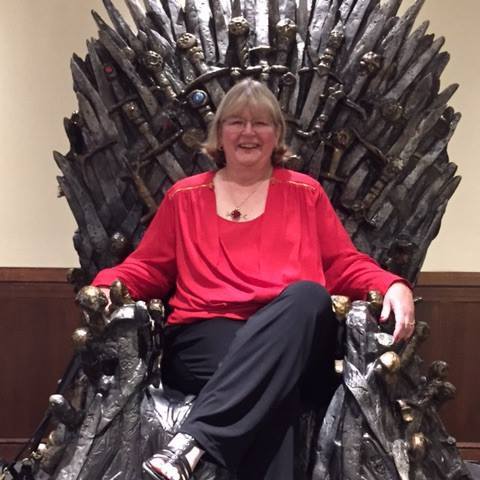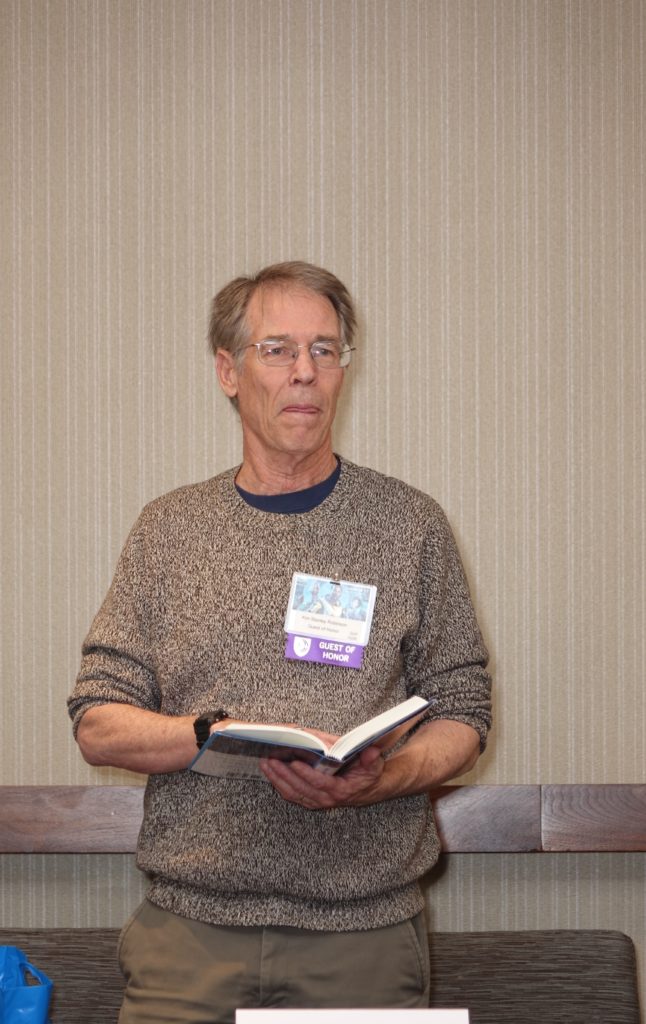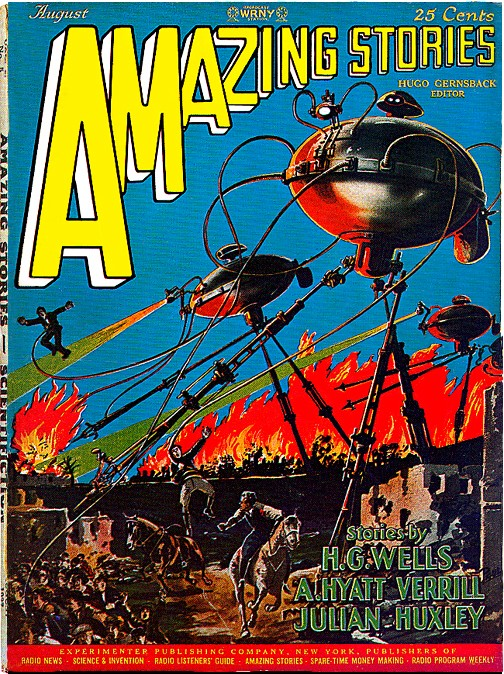(1) THE FATE OF U.S. WORLDCONS WEIGHED. Two editorials came out today addressing how Worldcons should react to the increased risks of international travel to the U.S.
The Unofficial Hugo Book Club Blog’s post “Worldcon In An Age Of American Truculence” concludes:
…Because of the voter base, institutional knowledge, and enormous fan base, US Worldcons will and should always occur. But perhaps there should be an increased willingness among fandom to support overseas conventions in locations that present logistical hurdles for North American travellers. If we may be so bold, perhaps we as fans should encourage the practice of having a Worldcon outside of North America every second year.
In an age of US truculence, Worldcon needs to embrace friends and allies around the globe without turning its back on the generations of fans and volunteers who have built it as an institution.
Gary Westfahl’s “Op-Ed: ‘No More Worldcons in the United States?’” at File 770 starts with a more draconian conclusion:
The time has come to cancel or move the 2025 Seattle Worldcon.
And to cancel or move the 2026 Los Angeles Worldcon.
It has to be done, in order to honor a century-old tradition of science fiction….
(2) FRANK R. PAUL AWARDS. Frank Wu has announced that the 2025 Frank R. Paul Awards will be presented at Philcon (November 21-23). Due to the lateness of the convention in the calendar, he is extending the deadline for submissions for the Frank R. Paul Awards for another month, to May 15. All artists, publishers and editors are enthusiastically encouraged to submit their 2024 work to the main awards administrator, Frank Wu, at FWu@Frankwu.com Details are available here: “Frank R. Paul Awards”.

(3) BALTICON SUNDAY SHORT SCIENCE FICTION FILM FESTIVAL 2025. [Item by lance oszko.] The Balticon Sunday Short Science Fiction Film Festival 2025 has curated 19 short films representing 8 countries. Featured are Short Stories adapted into Short Films.
Sunday 25 May 2025 7 p.m. to 11:30 p.m.
George RR Martin produced another Howard Waldrop film Mary Margaret Road Grader“. Estimated budget $2.2 Million. Director Steven Paul Judd is known for Dark Winds and Marvel’s Echo. It has a score by Game of Thrones composer Ramin Djawadi.
Italian Director Luca Caserta brings us The Reach. One of the last authorized Dollar Baby Stephen King Films.
With a song by Bruce Springsteen.
Director George Vatistas adapted The Hobbyist by Frederic Brown.Actor Stacy Thunes (Nosferatu – Head Nurse) currently at Universal Studios, Japan stars in The Hairdo.
An Old Friend. Director Nuk Suwanchote. An imaginary friend (Jason Faunt) finds out his sole purpose is to bring happiness to his child, only to discover his child is a 90 year old man (Tom Skerritt) on his deathbed.
First time Local filmmakers were also selected in Twilight Zone and Animation motifs.
Horror and Fantasy round out our offerings.
(4) “I’M NOT A ROBOT” [Item by lance oszko.] The Balticon Sunday Short Science Fiction Film Festival could not arrange a screening, but still worthy of your attention. “Watch The Surreal Identity Crisis of ‘I’m Not a Robot’” in The New Yorker.
(5) SFF BOOKS OUT OF NAVAL ACADEMY LIBRARY. Allen Steele pointed out that the list of 381 books pulled from the U.S. Naval Academy library (reported at the top of yesterday’s Scroll) includes several works of sff (even though the vast majority are nonfiction about gender issues or racism). Steele asks, “Wonder what Robert Heinlein would have to say about the actions of his Alma mater?”
The three sff works I found on the list are:
- Light From Uncommon Stars / RykaAoki.
- Sorrowland / Rivers Solomon
- A Psalm For The Wild-Built / Becky Chambers.
(6) AUSTEN IN INNSMOUTH. Deep Cuts in a Lovecraftian Vein finds much to enjoy in “’Innsmouth Park’ (2025) by Jane Routley”.
Jane Austen’s role in weird fiction is underappreciated, largely because she herself didn’t really write any (although Northanger Abbey is a biting satire of the Gothic novel, and a must-read for Gothic fans which even Lovecraft acknowledged, which has to at least classify Austen as weird fiction’s strange aunt.) Yet the world she described, the characters and milieu she envisioned, have been enduring and influential far beyond the genre she initially worked in. Generations of writers have called back to Austen, and mashups like Sense and Sensibility and Sea Monsters (2009) by Austen & Ben H. Winters, Regency Cthulhu (2023) by Andrew Peregrine & Lynne Hardy, and Secrets & Sacrifices: A Regency Cthulhu Novel (2024) by Cath Lauria all point to a similar rainy-day afternoon brainstorm:
Why not mix Austen and Lovecraft?…
(7) PEN AMERICA LITERARY AWARDS FINALISTS. There are almost no nominees of genre interest among the 2025 PEN America Literary Awards Finalists. The one exception is in this category, a work of horror fiction.
PEN Translation Prize ($3,000)
For a book-length translation of prose from any language into English.
The Empusium, Olga Tokarczuk. Translated from Polish by Antonia Lloyd-Jones (Riverhead Books)
(8) BBC COVERAGE OF BELFAST EASTERCON. Eastercon got a 15-minute slot on BBC Northern Ireland with Jo Zebedee and Ian McDonald doing an interview and chatting about it. “Saturday with John Toal – Puppets, Worms and Sci-fi”. Interview starts at 45m20s.
…As Belfast prepares to host a special Sci Fi convention Eastercon, for the first time in its 76 year history, John hears from two successful science fiction writers Ian McDonald and Jo Zebedee….
(9) STUNT OSCAR APPROVED. “Oscars Add Best Stunt Design Category Starting in 2027” – Variety has the story.
…“Since the early days of cinema, stunt design has been an integral part of filmmaking,” said Academy CEO Bill Kramer and Academy president Janet Yang. “We are proud to honor the innovative work of these technical and creative artists, and we congratulate them for their commitment and dedication in reaching this momentous occasion.”
In a statement, Leitch said, “Stunts are essential to every genre of film and rooted deep in our industry’s history—from the groundbreaking work of early pioneers like Buster Keaton, Harold Lloyd, and Charlie Chaplin, to the inspiring artistry of today’s stunt designers, coordinators, performers, and choreographers.” He went on to say, “This has been a long journey for so many of us. Chris O’Hara and I have spent years working to bring this moment to life, standing on the shoulders of the stunt professionals who’ve fought tirelessly for recognition over the decades. We are incredibly grateful. Thank you, Academy.”
…Category rules for eligibility and voting for the inaugural award will be announced in 2027 with the complete 100th Academy Awards Rules….
(10) BLACK MIRROR. “Black Mirror Season 7’s Tech Tales Come With a Knife-Twist of Emotion” — Gizmodo gets down to cases.
A new season of Black Mirror has arrived, and with it the usual cautionary tales (and screaming warnings) about technology’s darkest capabilities—wrapped in a deceptively alluring blanket of “Jeez, that would actually be really cool if it were real!” Across six episodes, season seven boasts some of the show’s all-time greatest performances, as well as its first sequel episode, which proves well worth the eight-year wait….
(11) MIDDLE-EARTH WAYFINDER. Wisconsin Public Radio profiles Karen Wynn Fonstad, “The Wisconsin cartographer who mapped Tolkien’s fantasy world”.
If you’ve ever wanted to explore the world of “The Hobbit” and “The Lord of the Rings,” the best place to start might be Oshkosh.
That’s where a Wisconsin cartographer created dozens of maps that went into “The Atlas of Middle-earth,” the official geographic guide to the world of author J.R.R. Tolkien. Her work went on to influence “The Lord of the Rings” movie trilogy.
Like many readers, Karen Wynn Fonstad fell in love with the fantasy series and went through multiple readings. Unlike most readers, she was trained as a cartographer, and came up with an ambitious plan to use the texts to create realistic maps from Tolkien’s texts.
Fonstad passed away 20 years ago. Now, her husband and her son — both geographers themselves — have embarked on a new quest: to digitize her original maps and find an archive to house them…
… “It’s a little bit of an overwhelming process because, first of all, there’s hundreds of maps. Secondly, the maps are built in such a way that they have many layers to them,” Mark said. “I barely scratched the surface this week.”
As we walk into the map library, we are surrounded by Middle-earth. Mordor, the Shire and all points in between are represented. And not just Middle-earth. Karen created works for other fantasy worlds — some never published.
How do you scan a collection of maps of varying sizes, some of them in delicate condition?
You need a big scanner, caution and some patience….
… In 1977, she called the American publisher of Tolkien’s work, Houghton Mifflin, to pitch the idea of an atlas. As Todd recalled, the person in charge of handling Tolkien’s work fell in love with the idea, and the Tolkien estate gave it the thumbs-up.
Then the work really began….
(12) MEMORY LANE.
[Written by Paul Weimer.]
Mad Max film (1979)
By Paul Weimer: The quintessential post-apocalyptic movie, the one with the real breakthrough. Sure, A Boy and His Dog and Damnation Alley and others preceded it, but this was the movie, series of movies that made a star of Mel Gibson, and the scenes of the Australian desert became the cinematic language and landscape of what a post apocalyptic world should look like in three movies that it took dozens for, say, the American Western.
That’s the power of Mad Max, that’s the power of George Miller’s cinematography. One could approach these movies from all sorts of angles, from worldbuilding to characterization, to point of view. As an example-the second movie, Mad Max 2 (The Road Warrior) is not told from the point of view and perspective that you’d expect. It’s a recreation, a retelling, and that brings in all sorts of interesting questions about narrative and conventions and storytelling.
Or one could explore Max as a character, from his end of the world cop, all through the damaged survivor in the latest Mad Max movie, where he literally is used as a resource.
Or one could explore environmental themes, social themes, and the psychology of the survivors of the landscape, from the small to the mighty.
But I want to talk a bit about cinematography, as a person interested in image, you are not surprised. One thing that told me and showed me that Miller “Still had it” in Fury Road was the scene with the dust storm and the vehicles approaching it. You know the scene if you watched it. It was solid proof for me that Miller’s fantastic cinematography, to be able to bring the wildness of the Australian wasteland to life in the previous films, was still there. It recalled for me of many of the other iconic places and imagery used in the series, from Thunderdome back through the mean streets of Melbourne in Mad Max. The lack of dialogue in much of the films means that Miller’s storytelling in the films is necessarily what the movies are carried on. And it is indeed carried so effectively. You remember the visuals, the costumes, the sets, and of course the vehicles. How many gearheads were born from watching these movies?
One last fun note on Mad Max. The first bit of Mad Max I saw was not until the mid 80’s. I accidentally caught the last few minutes on a videotape recording of Mad Max 2 while trying to (don’t judge) see D.C. Follies. I wondered what the heck I had watched and looked it up in the TV guide…and then I recorded and watched The Road Warrior and was captivated. Later, I found the original Mad Max…and then, of course Thunderdome.
Mad Max. A cinematic icon, four movies (5 if you count Furious) and counting.

(13) COMICS SECTION.
- Free Range witnesses young Escher at school.
- Rhymes with Orange reads the room.
- Rubes recalls a song.
- The Flying McCoys adds realism to Homer’s epic.
(14) TWO HEARTS AND TWO EARS. “Graham Norton to star in Eurovision-themed Doctor Who episode” reports BBC.
Graham Norton is to star in a new episode of Doctor Who, taking his Eurovision commentary duties to an Interstellar Song Contest.
Norton, the BBC’s voice of Eurovision, will meet Ncuti Gatwa’s Time Lord at the 803rd annual Interstellar Song Contest, where different planets compete to be crowned winner.
“And it’s not just a cameo,” showrunner Russell T Davies said. “He has a whole plot twist all to himself!”
The episode will also feature fellow Eurovision fanatic and broadcaster Rylan Clark as the event’s co-host, and will be broadcast on BBC One just before this year’s real-life grand final on 17 May….
(15) THOUGHT EXPERIMENT. “How might AI chatbots replace mental health therapists?” asks The Week.
There is a striking shortage of mental health care providers in the United States. New research suggests that AI chatbots can fill in the gaps — and be remarkably effective while doing so.
Artificial intelligence can deliver mental health therapy “with as much efficacy as — or more than — human clinicians,” said NPR. New research published in the New England Journal of Medicine looked at the results delivered by a bot designed at Dartmouth College.
What did the commentators say?
There was initially a lot of “trial and error” in training AI to work with humans suffering from depression and anxiety, said Nick Jacobson, one of the researchers, but the bot ultimately delivered outcomes similar to the “best evidence-based trials of psychotherapy.” Patients developed a “strong relationship with an ability to trust” the digital therapist, he said.
Other experts see “reliance on bot-based therapy as a poor substitute for the real thing,” said Axios. Therapy is about “forming a relationship with another human being who understands the complexity of life,” said sociologist Sherry Turkle. But another expert, Skidmore College’s Lucas LaFreniere, said it depends on whether patients are willing to suspend their disbelief. “If the client is perceiving empathy,” he said, “they benefit from the empathy.”….
(16) UPON FURTHER CONSIDERATION. “MIT study finds that AI doesn’t, in fact, have values” says TechCrunch.
A study went viral several months ago for implying that, as AI becomes increasingly sophisticated, it develops “value systems” — systems that lead it to, for example, prioritize its own well-being over humans. A more recent paper out of MIT pours cold water on that hyperbolic notion, drawing the conclusion that AI doesn’t, in fact, hold any coherent values to speak of.
The co-authors of the MIT study say their work suggests that “aligning” AI systems — that is, ensuring models behave in desirable, dependable ways — could be more challenging than is often assumed. AI as we know it today hallucinates and imitates, the co-authors stress, making it in many aspects unpredictable.
“One thing that we can be certain about is that models don’t obey [lots of] stability, extrapolability, and steerability assumptions,” Stephen Casper, a doctoral student at MIT and a co-author of the study, told TechCrunch. “It’s perfectly legitimate to point out that a model under certain conditions expresses preferences consistent with a certain set of principles. The problems mostly arise when we try to make claims about the models, opinions, or preferences in general based on narrow experiments.”
Casper and his fellow co-authors probed several recent models from Meta, Google, Mistral, OpenAI, and Anthropic to see to what degree the models exhibited strong “views” and values (e.g., individualist versus collectivist). They also investigated whether these views could be “steered” — that is, modified — and how stubbornly the models stuck to these opinions across a range of scenarios.
According to the co-authors, none of the models was consistent in its preferences. Depending on how prompts were worded and framed, they adopted wildly different viewpoints.
Casper thinks this is compelling evidence that models are highly “inconsistent and unstable” and perhaps even fundamentally incapable of internalizing human-like preferences….
(17) BIRD WORRIES. “Conservationists raise alarm over Air Force plan to land SpaceX Starships on bird sanctuary atoll” reports Space.com.
The U.S. military is considering Johnston Atoll, a remote Pacific island chain that serves as an important refuge for dozens of seabird species, for “two commercial rocket landing pads” to test giant cargo rocket landings for the Department of the Air Force’s (DAF) Rocket Cargo Vanguard program, and it’s getting push-back from environmentalists.
The Rocket Cargo Vanguard program aims to develop the technologies required to rapidly deliver up to 100 tons of cargo anywhere on Earth using commercial rockets. Though not explicitly named, Elon Musk’s SpaceX is currently the only company —commercial or otherwise — capable of manufacturing rockets designed for landing and reuse, and its Starship megarocket is DAF’s leading contender. The Air Force outlined its plans in a Federal Registry notice last month. Objections from the American Bird Conservancy (ABC), however, may hinder plans for the new landing pads on the South Pacific atoll.Johnston Atoll lies about 825 miles (1,325 kilometers) southwest of Hawaii, and is home to several different species of seabirds, including the largest known colony of Red-tailed Tropicbirds. It was designated a refuge for native bird populations in 1926, but suffered environmental degradation through 2004, due to its use by the U.S. military as a nuclear weapons testing and chemical weapons disposal site. Since the military’s departure from the islands, restoration efforts have helped raise Johnston Atoll’s bird population back to nearly 1.5 million.
(18) ARE YOU GOING TO BELIEVE YOUR LYING EYES? “Purple Isn’t Real, Science Says. Your Brain Is Just Making It Up” reports Popular Mechanics. If there is no purple, does that mean there can be no purple people eaters?
You might be today years old when you realize there is no purple in the rainbow. There is no P in ROYGBIV.
But wait, what about violet? Well, despite what you may have come to believe, violet is not purple. In fact, violet (along with the rest of the colors in a naturally occurring rainbow) has something purple doesn’t—its own wavelength of light. Anyone who ever ended up with a sunburn knows violet wavelengths are real, as the Sun’s ultraviolet (UV) radiation is the reason you need to wear sunscreen, even though you can’t see those wavelengths (more on that later). Red, orange, yellow, green, blue, and indigo are all just as real.
But purple? Well, purple is just your brain’s way of resolving confusion.That’s right. Red and blue (or violet) wavelengths are two opposite extremes on the spectrum. When you see both of these wavelengths in the same place, you eyes and brain don’t know what to do with them, so they compensate, and the clashing wavelengths register as the color we call purple. It doesn’t actually exist….
[Thanks to Andrew Porter, John King Tarpinian, Chris Barkley, Steven H Silver, lance oszko, Frank Wu, James Bacon, Allen Steele, Cat Eldridge, SF Concatenation’s Jonathan Cowie, Mark Roth-Whitworth, Steven French, Kathy Sullivan, Teddy Harvia, and Mike Kennedy for some of these stories. Title credit belongs to File 770 contributing editor of the day Dan’l.]












